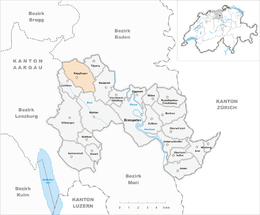Hägglingen
| Hägglingen | ||
|---|---|---|
 |
||
|
||
| Coordinates: 47°23′N 8°15′E / 47.383°N 8.250°ECoordinates: 47°23′N 8°15′E / 47.383°N 8.250°E | ||
| Country | Switzerland | |
| Canton | Aargau | |
| District | Bremgarten | |
| Area | ||
| • Total | 7.75 km2 (2.99 sq mi) | |
| Elevation | 472 m (1,549 ft) | |
| Population (Dec 2015) | ||
| • Total | 2,419 | |
| • Density | 310/km2 (810/sq mi) | |
| Postal code | 5607 | |
| SFOS number | 4068 | |
| Surrounded by | Dottikon, Mägenwil, Niederwil, Othmarsingen, Tägerig, Wohlen, Wohlenschwil | |
| Website |
www SFSO statistics |
|
Hägglingen is a municipality in the district of Bremgarten in the canton of Aargau in Switzerland.
The first evidence of a settlement comes from barrows from the Hallstatt period. There is also evidence of small Roman era settlements.
The first mention of modern Hägglingen is in 1036 when Count Ulrich von Lenzburg granted the church and farm of Hekelingen to Beromünster. In the acknowledgments of Emperor Henry III in 1045, the village of Hackelingen was mentioned. Frederick I Barbarossa acknowledged the grants to the village in 1173. The Vogtei (balliwick) went from the Lenzburg family to the Kyburgs and then in 1273 to the Lords of Hallwyl. The high court rights were exercised by the Habsburgs until the Swiss conquered the Aargau in 1415. It was not until 1425 that Hägglingen, which was claimed by Lucerne, came under the authority of the entire Confederacy. It was first assigned to the district court of Wohlenschwil before it became an independent municipality from 1435-1712.
The Dorfoffnung regulations of 1609 include laws for the exploitation of forests and regulated irrigation. At this time Hägglingen was acting as a fully independent municipality. Between 1611-13, 150 people died of the plague. It was sacked and partly burned in 1656 by Bernese troops.
The parish church of St. Michael was built in 1457-66, though only the tower and choir of the original church were retained. The church was expanded in 1638-39, and renovated in 1739. In 1951, the late gothic choir frescoes of 1480-90, which had survived the iconoclasm of 1529, were discovered.
...
Wikipedia




